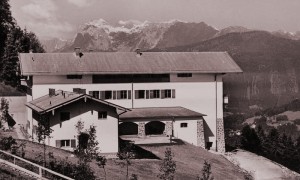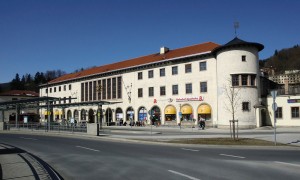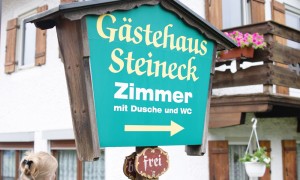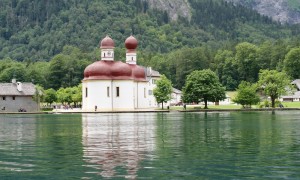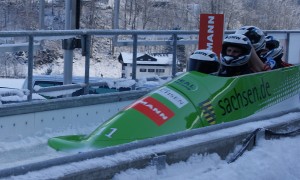Located in the south of the Berchtesgadener Land, the market town of Berchtesgaden has been as much as anything associated with the National Socialist regime, in that it was on the nearby Obersalzberg that Nazi leader Adolf Hitler and a number of his entourage – among them Martin Bormann, Hermann Göring and Albert Speer – chose to have second homes.
While Hitler and the Nazi regime will be forever linked with the history of the town, it is worth noting that his reasons for moving to the region were in fact rather ordinary: as a man who disliked the city and the hustle and bustle of urban life, his home on the Obersalzberg offered a haven of peace and tranquility. It is a feeling that many of us share, and it is indeed this feeling that makes the Berchtesgadener Land appealing to the tens of thousands who travel to the region every year.
Although the few final remains of Hitler’s house on the Obersalzberg – the Berghof – have long since been removed, one can still see and experience this history today, not only in the Kehlsteinhaus itself but also in the many small museums and other related places of interest, some of which are not immediately obvious. For instance, both the post office building and the classically-designed Hauptbahnhof (main station) date back to the Nazi era, with the latter having been opened in February 1940 to serve visiting dignitaries. ![]()
![]() Did You Know?Berchtesgaden is the smallest town in Germany with a Hauptbahnhof (main railway station).
Did You Know?Berchtesgaden is the smallest town in Germany with a Hauptbahnhof (main railway station).
Berchtesgaden and the surrounding area are well equipped with all of the essential facilities one would expect of any region geared to the tourist industry. As well as a number of excellent hotels, one can find many privately-run guesthouses offering bed and breakfast at reasonable rates as well as self-catering accommodation and a number of well-run camp sites in and around the Nationalpark Berchtesgaden.
The Berchtesgaden-Königssee region is made up of Berchtesgaden, Bischofswiesen, Marktschellenberg, Schönau am Königsee (comprising of Unterschönau, Oberschönau and Königssee) and Ramsau bei Berchtesgaden. Other smaller settlements include Engedey, Mitterbach, Oberau, Unterau, Schwöb, Stanggaß, Strub, and the Obersalzberg.
Accommodation and Facilities
As befits a region that is a popular tourist destination both in summer and in winter, accommodation can also be found both in Berchtesgaden itself as well as in most of the smaller surrounding towns and villages. Private accommodation – indicated by the many signs saying “Zimmer frei” – is fairly easy to find, rates are reasonable, and the public transport connections are excellent. If you are visiting during the winter you will need to watch out for the shorter timetables, but during the summer – when the Kehlsteinhaus is open – all of the local bus services run well into the evening.
Although it is possible to find an available room on arrival, it is usually best to book in advance, either with individual private owners directly or through the local tourist office (www.berchtesgadener-land.com). As well as accommodation in family homes you can also find plenty of available self-catering accommodation – in German, Ferienwohnung. For all of those in self-catering in need of supplies there are two well-stocked supermarkets – a Lidl and a Rewe – both of which are a short walking distance from Berchtesgaden Hauptbahnhof.
Most hotels and privately-run guesthouses will also include special guest travel cards (Gästekarten) which provide visitors with free and reduced facilities throughout the entire Berchtesgaden and Königssee region. The Berchtesgaden-Königssee Gästekarte can be used for reduced entry fees at the majority of local attractions, free parking in municipal car parks, and free travel on local bus services. ![]()
![]() Did You Know?For visitors to the Kehlsteinhaus, the Berchtesgaden-Königssee Gästekarte offers a €1,50 reduction on a standard adult return ticket.
Did You Know?For visitors to the Kehlsteinhaus, the Berchtesgaden-Königssee Gästekarte offers a €1,50 reduction on a standard adult return ticket.
Most of the smaller towns are conveniently self-contained, with small local grocery stores and restaurants. Indeed, all of the restaurants recommended by the author of this site are outside of the main town of Berchtesgaden, with Schönau am Königssee in particular offering a selection of ambient establishments that serve hearty and reasonably-priced local dishes.
Recommended Restaurants
Gasthaus zum Unterstoa, Untersteinerstraße 11, 83471 Schönau am Königssee. www.gasthaus-unterstein.de
Gasthof Bodner, Oberschönauer Straße 10, 83471 Schönau am Königssee. www.gasthof-bodner.com
Gasthof Kohlhiasl, Oberschönauer Straße 44, 83471 Schönau am Königssee. www.gasthof-kohlhiasl.de
Other Attractions
As well as the Kehlsteinhaus, there are plenty of nearby attractions on offer, including the Nationalpark Berchtesgaden, the scenic cable-car journey up the Jennerbahn, the historic salt mine and salt mine museum at the Salzbergwerk, and the many picture-postcard locations dotted around the crystal clear waters of the 7.7 kilometre long and 185 metre-deep Königssee (“King’s Lake”).
On the shores of the Königssee can be found the tiny enclave of Sankt Bartholomä, whose claims to fame include its beautiful Baroque church and the famous fishery restaurant, the Fischerstüberl. Then of course there is the imposing Watzmann, at 2713 metres (8900 ft.) the tallest mountain in the region.
In contrast to the sedate and tranquil beauty of Sankt Bartholomä there is also the Sommerrodelbahn (summer toboggan) located by the Gasthof Hochlenzer, conveniently located on the Scharitzkehlstraße.
The region is also a popular winter destination, and is home to a number of major international winter sport events. The Königssee Bobbahn is the oldest artificial sliding sports track in the world, and is a fixture on the annual world cup circuit.
Two weekends in early January are devoted to both the luge and bobsleigh/skeleton world cup events – the perfect reason for heading out to the Berchtesgadener Land even when the Kehlsteinhaus is closed. You can even get a decent of shot of the Kehlsteinhaus covered in snow!


